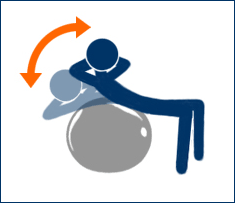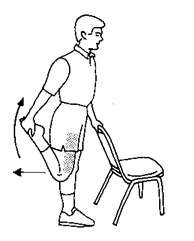Many of us grew up with the idea that stretching before a workout will reduce our chance of injury. However, the newest research does not support this idea, especially for runners. It’s better to workout first or at least do a good warmup. Part of your warmups can be a slower version of the exercise you intend to do, to loosen up your muscles and joints. Then, 10 minutes of a good paced walk or riding a bike will complete a reasonable warm up. Then you can proceed to proper, deep stretches. Alternatively, you could just wait and stretch after your workout.
After your warmup, do some easy gentle stretches repeatedly. Then progress to deeper reaching or pulling, gradually. For instance, touching your toes – generally reach up first, then slowly lean over and reach gently towards the toes. Don’t force this stretch, let gravity do most of the work, and stop if there is any pain. Be aware of what is stretching and don’t over do it. Do you feel the back of your legs a little tight? Is your lower back feeling tight? Don’t force anything that is tight, keep the stretch gentle and give it lots of time. You should hold most stretches for at least 15 seconds. Repeat a few times until you don’t feel any more improvement. That may be enough for this day. If you keep your stretches gentle you could stretch everyday, otherwise, three times a week may suffice. The best time to stretch is after your workout before you cool down. At this time your muscles are easier to stretch and will less likely be injured.
Remember to stretch the large muscles that you used during your workout. Let’s say you haven’t done any running for a few weeks and it’s a beautiful day, so you run for 30 minutes. The next day you will likely notice sore leg muscles. This is when stretching helps the most. Your muscles were not accustomed to that much running, so they end up being inflamed with a few microtears in the muscle fibers. These microtears will heal with scar tissue and make the muscle stronger but will also shorten the muscle. That’s why you need to stretch them. Also, when you make time to stretch you should focus on the one or two muscles that you know need to be worked on. You don’t know which ones are tight? Visit your Chiropractor, physiotherapist or fitness trainer and have them check for you.
Some muscles you can test yourself at home. Try bending over to touch your toes. For some this is easy, but others might be 10, 20 or even 30 centimeters away. It is considered normal range of motion to be able to touch with no real effort. So, if you can’t, make this hamstring and lower back stretch part of your regular stretching. Maybe you can’t stand and touch you heel to your buttock? Hint you must keep your thighs parallel in line with your trunk. If you do this stretch and feel any pain in the knee, stop. You should feel a stretch in the front of your thigh.
Perhaps your mid-back feels stiff after raking, shovelling, or prolonged sitting. One of the best stretches for this is to lie back on a big yoga ball or a foam roller. You can use a rolled-up towel. Lie back with your midback on the ball. With the back of your head in your hands push your elbows back, pull your chin in and push your neck back.
Tight muscles and joints lead to pain and mechanical problems eventually. For instance, tightness around your hip may cause pain in the knee. Stay ahead of this with regular stretching. It doesn’t take much to maintain your flexibility once you have it back to normal. If you over-do it with some activity, then you need a little more stretching afterwards. Keep looking for areas that feel better after you stretch them and check back by trying the stretch regularly. You’ll be glad you did.
Lastly, I recently heard of a good idea about how long to hold your stretch. We usually say at least 15 seconds. However, you may find that difficult to count out without using a timer. A great alternative is to focus on and count your breaths. Each breath may be 3-5 seconds, so you don’t need as many. But here, you focus on the feeling of the stretch more, especially when exhaling. You should notice a letting go of the muscle as you breath out.
Stretching isn’t exactly good cardio exercise, but it sure beats prolonged sitting.




